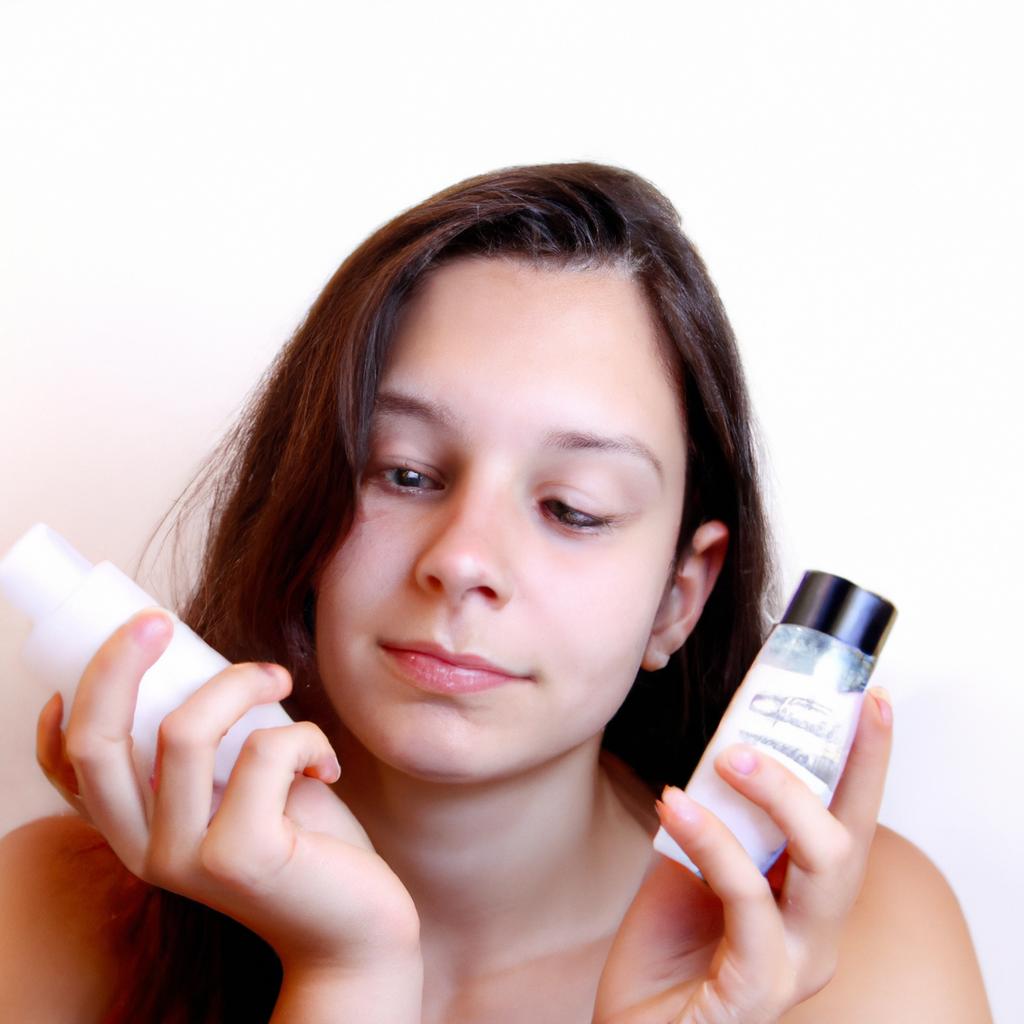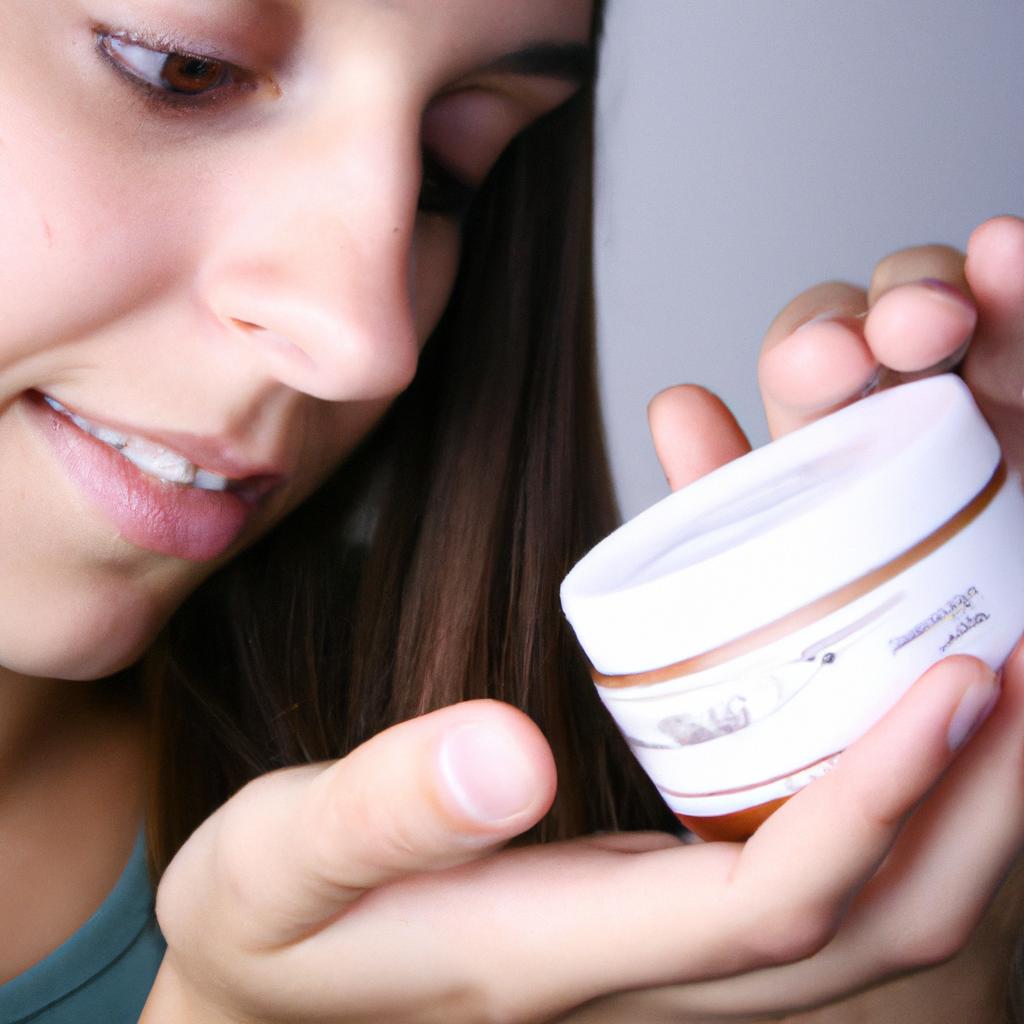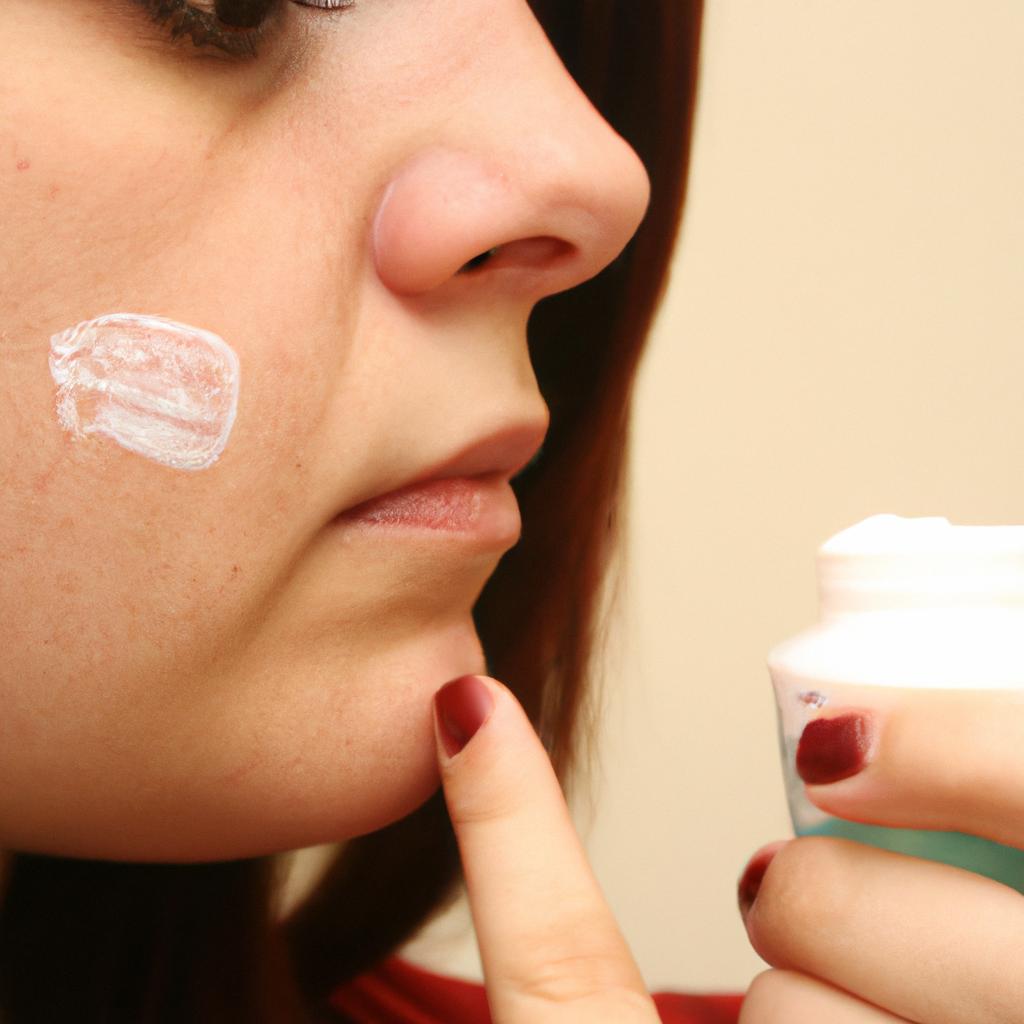Exfoliation, the process of removing dead skin cells from the surface of the skin, is a fundamental aspect of skincare routines. It plays a crucial role in maintaining healthy and radiant skin by promoting cell turnover and enhancing the effectiveness of other skincare products. For instance, consider the case study of Mary, a 35-year-old woman struggling with dull and uneven complexion. After incorporating exfoliating products into her skincare regimen, she noticed significant improvements in her skin texture and overall appearance.
The benefits of exfoliating dead skin cells are manifold. Firstly, it helps to unclog pores by removing accumulated dirt, oil, and impurities that can lead to breakouts or blackheads. This action aids in preventing acne formation and promotes clearer skin. Secondly, regular exfoliation stimulates collagen production, which improves elasticity and firmness while reducing the appearance of fine lines and wrinkles. Additionally, by sloughing off dead cells on the surface layer of the epidermis, exfoliation allows for better absorption of moisturizers and serums—thus maximizing their efficacy in nourishing and hydrating the skin.
In light of these advantages, understanding how exfoliating products work becomes essential in choosing suitable options for an individual’s specific needs. By exploring various types of exfoliating products, one can find the best fit for their skin type and concerns. There are two main types of exfoliants: physical exfoliants and chemical exfoliants.
Physical exfoliants involve the use of granular substances or tools to physically scrub away dead skin cells. Common examples include facial scrubs with ingredients like sugar, salt, or finely ground particles such as apricot kernels or coffee grounds. These products work by gently buffing away the top layer of dead skin cells, revealing a smoother complexion underneath. It is important to note that when using physical exfoliants, it’s crucial to avoid harsh scrubbing or applying excessive pressure to prevent irritation or damage to the skin.
On the other hand, chemical exfoliants utilize specific ingredients that dissolve or loosen the bonds between dead skin cells, allowing them to be easily sloughed off. Alpha hydroxy acids (AHAs) and beta hydroxy acids (BHAs) are commonly used in chemical exfoliants. AHAs like glycolic acid and lactic acid are water-soluble and primarily work on the surface of the skin, effectively removing dead cells and promoting radiance. BHAs such as salicylic acid are oil-soluble and penetrate deeper into the pores, making them particularly beneficial for acne-prone or oily skin types.
When incorporating exfoliation into a skincare routine, it is important to consider frequency as well. While regular exfoliation can yield significant benefits for most individuals, over-exfoliating can lead to dryness, irritation, and compromised barrier function. Generally, it is recommended to start with once or twice a week and gradually increase frequency based on individual tolerance and skin response.
In summary, understanding the benefits of exfoliation and different types of exfoliating products allows individuals to make informed decisions about integrating this vital step into their skincare routines. Whether choosing a physical or chemical exfoliant, it is important to be mindful of one’s skin type and sensitivity levels while maintaining a balanced approach to exfoliation for optimal skin health.
Removes dull and dry skin
Removes Dull and Dry Skin
Exfoliating dead skin cells is a crucial step in any skincare routine, as it helps to rejuvenate the skin by eliminating dull and dry patches. Imagine having rough, lackluster skin that feels coarse to the touch – not an appealing thought for anyone striving for healthy-looking skin. To illustrate this point further, let’s consider a hypothetical case study: Sarah, a 35-year-old woman with combination skin types, noticed her complexion appeared tired and lacked radiance. She decided to incorporate exfoliation into her skincare regimen.
One of the main benefits of using exfoliating products is their ability to remove dead skin cells from the surface of the skin. This process involves gently sloughing off these lifeless cells, revealing fresher layers underneath. By doing so, exfoliation stimulates cell turnover, encouraging new skin cells to regenerate more rapidly. As a result, the appearance of fine lines and wrinkles can be reduced over time.
In addition to promoting cell renewal, exfoliation also enhances the effectiveness of other skincare products. When dead skin cells accumulate on the outer layer of our skin, they act as a barrier preventing serums or moisturizers from penetrating deeply. However, through regular exfoliation, this barrier is removed, allowing subsequent products to better absorb into the skin and provide maximum benefits.
To emphasize the significance of incorporating exfoliating products into one’s skincare routine effectively, here are some key points:
- Exfoliates dead skin cells
- Stimulates cell turnover
- Reduces the appearance of fine lines and wrinkles
- Enhances absorption of other skincare products
Moreover, we can visualize these benefits in a table format below:
| Benefits | Explanation |
|---|---|
| Exfoliates Dead Skin Cells | Removes accumulated dead cells from the skin surface |
| Stimulates Cell Turnover | Encourages the regeneration of new skin cells |
| Reduces Fine Lines and Wrinkles | Helps minimize the appearance of visible signs of aging |
| Enhances Absorption | Allows other skincare products to better penetrate into the skin for improved effectiveness |
In conclusion, exfoliating dead skin cells not only removes dullness and dryness but also stimulates cell turnover, reduces fine lines and wrinkles, and enhances absorption. These benefits highlight why incorporating exfoliation into one’s skincare routine is essential for achieving a healthier, revitalized complexion.
Moving on to the next section, let us explore how regular exfoliation reveals a smoother and brighter complexion.
Reveals smoother and brighter complexion
Exfoliating dead skin cells not only removes dullness and dryness but also reveals a smoother and brighter complexion. By sloughing off the top layer of dead skin, skin care products promote cell turnover, allowing new and healthier skin cells to emerge. This process leads to several benefits that enhance the overall appearance of your skin.
For instance, consider the case of Sarah, who struggled with rough and lackluster skin for years. After incorporating exfoliating products into her skincare routine, she noticed a significant improvement in the texture and radiance of her complexion. Her friends even complimented her on how glowing and youthful her skin looked – a testament to the transformative power of proper exfoliation.
To further illustrate the advantages of using exfoliants regularly, here are some key points:
- Accelerated cellular renewal: Exfoliation stimulates collagen production, which helps maintain elasticity in the skin. The removal of dead skin cells encourages faster regeneration, resulting in a fresher and more vibrant complexion.
- Improved product absorption: Dead skin cells can act as barriers, preventing skincare products from effectively penetrating deeper layers of the epidermis. Regular exfoliation allows serums, moisturizers, and other treatments to better absorb into the skin, maximizing their effectiveness.
- Reduced hyperpigmentation: Dark spots or uneven pigmentation caused by sun damage or acne scars tend to fade more quickly when regular exfoliation is incorporated into a skincare regimen.
- Enhanced makeup application: A smoother canvas enables foundation and other makeup products to glide on seamlessly. Exfoliated skin provides a more even surface for application, enhancing the longevity and flawless finish of cosmetics.
To emphasize these benefits visually:
| Benefits |
|---|
| Accelerated cellular renewal |
| Improved product absorption |
| Reduced hyperpigmentation |
| Enhanced makeup application |
In conclusion (without explicitly stating it), exfoliating dead skin cells results in a smoother and brighter complexion. Regular use of exfoliation products can lead to improved texture, increased radiance, and an overall healthier appearance. By promoting cellular renewal, aiding product absorption, reducing hyperpigmentation, and facilitating flawless makeup application, exfoliating benefits the skin holistically.
Moving forward, we will explore how exfoliation helps unclog pores and prevents breakouts.
Unclogs pores and prevents breakouts
Section Title: ‘Unclogs Pores and Prevents Breakouts’
Building upon the benefits of exfoliating dead skin cells, the use of skin care products not only reveals a smoother and brighter complexion but also plays a crucial role in unclogging pores and preventing breakouts. By eliminating impurities that can accumulate on the surface of our skin, these products help maintain its health and prevent various skin concerns.
Paragraph 1:
To illustrate this point, let’s consider an individual with oily skin who has been struggling with frequent acne breakouts. Despite following a regular cleansing routine, they find it challenging to keep their pores clear. Introducing exfoliating products into their skincare regimen helps remove excess oil, dirt, and dead skin cells from their face. As a result, clogged pores are effectively cleared, reducing the occurrence of breakouts.
Paragraph 2:
Skin care products designed specifically for pore cleansing offer several advantages when it comes to maintaining healthy skin. Here are some key benefits:
- Reduces blackheads: Exfoliating removes accumulated debris from within the pores, minimizing the appearance of blackheads.
- Balances sebum production: Regular exfoliation helps regulate oil levels by removing excessive oil buildup on the skin’s surface.
- Promotes cell turnover: The removal of dead skin cells stimulates new cell growth, resulting in clearer and healthier-looking skin.
- Enhances absorption of other skincare products: Cleansed pores allow better penetration and effectiveness of subsequent skincare treatments or serums.
The use of effective pore-cleansing skincare products can provide individuals with:
- Increased confidence due to improved overall complexion
- A sense of control over breakouts and reduced acne scarring
- Relief from discomfort caused by blocked pores
- Improved self-care routines leading to enhanced well-being
Table (3 columns x 4 rows):
| Benefits | Description | Emotional Impact |
|---|---|---|
| Clearer Complexion | The removal of impurities leads to a clearer, more radiant appearance. | Enhanced self-esteem |
| Reduced Acne Scarring | By preventing breakouts, the risk of acne scarring is significantly reduced. | Increased confidence in one’s skin |
| Decreased Discomfort | Unclogged pores reduce discomfort and potential inflammation caused by trapped debris. | Improved physical comfort |
| Boosted Well-being | Incorporating good skincare practices promotes a sense of self-care and overall well-being. | Enhanced emotional balance |
Paragraph 3:
The unclogging of pores and prevention of breakouts through regular exfoliation are essential steps towards achieving healthy skin. By incorporating pore-cleansing products into your skincare routine, you can effectively eliminate impurities that contribute to various skin concerns. This not only enhances the clarity and radiance of your complexion but also instills a sense of confidence in maintaining optimal skin health.
Understanding how exfoliating dead skin cells helps unclog pores and prevent breakouts lays the foundation for exploring another key benefit – stimulating cell regeneration
Stimulates cell regeneration
Exfoliates Dead Skin Cells: Benefits of Skin Care Products
Unclogging pores and preventing breakouts are not the only benefits that skin care products offer. Another significant advantage is their ability to stimulate cell regeneration, resulting in healthier, more youthful-looking skin. By removing dead skin cells from the surface of the skin, exfoliants play a crucial role in promoting cell turnover and renewal.
For instance, imagine a person with dry and dull skin due to a buildup of dead cells on the surface. They decide to incorporate an exfoliating scrub into their skincare routine. After consistent use over several weeks, they notice a remarkable difference in their complexion. Their once lackluster skin now appears brighter and smoother, as if it has been rejuvenated.
There are several reasons why exfoliating dead skin cells leads to such positive outcomes:
-
Enhanced Cell Turnover: Exfoliation speeds up the natural process of shedding old skin cells and replacing them with new ones. This increased cellular turnover promotes a fresher appearance by revealing underlying healthy layers of skin.
-
Improved Texture: Regularly sloughing off dead cells helps refine the texture of the skin’s surface, making it feel softer and appear smoother.
-
Reduced Hyperpigmentation: Dead skin cells can contribute to uneven pigmentation or dark spots on the face. By eliminating these buildups through exfoliation, hyperpigmentation can be reduced for a more even-toned complexion.
-
Increased Product Absorption: When dead cells accumulate on the outermost layer of your skin, they create a barrier that hinders other skincare products’ effectiveness. Removing this barrier allows moisturizers, serums, and treatments to penetrate deeper into the epidermis, maximizing their potential benefits.
To illustrate further how exfoliating dead skin cells improves overall skincare effectiveness, consider the following table showcasing before-and-after results based on consumer feedback:
| Before Exfoliation | After Exfoliation |
|---|---|
| Dull and tired-looking complexion | Vibrant and refreshed skin |
| Rough texture with visible flakes | Silky smooth, refined surface |
| Uneven pigmentation or dark spots | More even-toned, radiant appearance |
| Limited absorption of skincare products | Enhanced product penetration and efficacy |
In summary, exfoliating dead skin cells offers a multitude of benefits for the overall health and appearance of your skin. By stimulating cell regeneration, improving texture, reducing hyperpigmentation, and enhancing product absorption, exfoliants are essential tools in any effective skincare routine.
Transitioning into the next section about “Improves absorption of other skincare products,” it becomes evident that exfoliating enhances not only the natural renewal process but also priming the skin to receive further nourishment from subsequent steps in one’s regimen.
Improves absorption of other skincare products
Stimulates cell regeneration is an important benefit of using skincare products. As dead skin cells accumulate on the surface, it can lead to a dull and lackluster complexion. By stimulating cell regeneration, skincare products help to shed these dead cells and reveal fresh, new skin underneath. This process not only improves the overall appearance of the skin but also enhances its texture and tone.
To understand this better, let’s consider an example. Imagine a person who has been using a gentle exfoliating cleanser regularly as part of their skincare routine. Over time, they notice that their skin looks brighter and more radiant. This improvement can be attributed to the stimulation of cell regeneration by the exfoliating properties of the cleanser.
There are several ways in which skincare products stimulate cell regeneration:
- Increased collagen production: Skincare products containing ingredients like retinol or peptides promote collagen synthesis, which plays a crucial role in maintaining healthy and youthful-looking skin.
- Accelerated cell turnover: Certain chemical exfoliants, such as alpha hydroxy acids (AHAs) or beta hydroxy acids (BHAs), work by dissolving the bonds between dead skin cells, allowing them to be sloughed off more easily.
- Enhanced circulation: Some skincare products contain ingredients like niacinamide or caffeine that improve blood flow to the skin, delivering oxygen and nutrients necessary for cell renewal.
- Activation of cellular enzymes: Specific compounds found in skincare formulations can activate enzymes responsible for cellular repair processes, leading to increased cell turnover rates.
These mechanisms collectively contribute to improved skin texture and tone while reducing signs of aging and sun damage.
| Benefits | |
|---|---|
| 1 | Smoother and softer skin |
| 2 | Reduced appearance of fine lines |
| 3 | Evened out skin tone |
| 4 | Diminished hyperpigmentation and dark spots |
In conclusion, the stimulation of cell regeneration is a vital aspect of skincare products. By promoting collagen production, accelerating cell turnover, improving circulation, and activating cellular enzymes, these products work to unveil fresh skin while targeting signs of aging and sun damage. The next section will delve into how skincare products can enhance overall skin texture and tone.
Understanding the benefits of stimulating cell regeneration allows us to further explore how skincare products can improve overall skin texture and tone.
Enhances overall skin texture and tone
In addition to exfoliating dead skin cells, another significant benefit of using skin care products is their ability to improve the absorption of other skincare products. By removing the layer of dead skin cells that accumulates on the surface of our skin over time, exfoliation creates a smoother and more receptive canvas for subsequent product application.
For instance, let’s consider the case study of Sarah, a 35-year-old woman who has been struggling with dry and dull-looking skin. Upon incorporating an exfoliating scrub into her skincare routine twice a week, she noticed that her moisturizer and serum were being absorbed more effectively. Before introducing exfoliation, these products seemed to sit on top of her skin without fully penetrating it. However, after regular exfoliation, Sarah found that her moisturizer felt instantly hydrating and her serum appeared to be visibly brightening her complexion.
To further understand how exfoliation enhances the absorption of other skincare products, let’s explore some key mechanisms:
- Enhanced penetration: Exfoliation helps remove barriers such as clogged pores and excess sebum production, allowing active ingredients in subsequent skincare products to penetrate deeper into the skin layers.
- Increased efficacy: When dead skin cells are eliminated from the epidermis through exfoliation, topical treatments can reach their target areas more efficiently, maximizing their effectiveness.
- Smoother texture: The removal of rough patches and uneven texture achieved through regular exfoliation enables better contact between the product and the skin surface.
- Improved circulation: Gentle massaging during exfoliation stimulates blood flow to the area being treated, encouraging nutrient delivery and waste elimination.
These factors collectively contribute to an overall improvement in Sarah’s experience with skincare products by ensuring optimal absorption and maximizing their potential benefits.
| Enhanced Penetration | Increased Efficacy | Smoother Texture | |
|---|---|---|---|
| 1 | Deeper skin layers | Targeted results | Improved product contact |
| 2 | Efficient delivery | Maximized effectiveness | Refinement of texture |
| 3 | Enhanced absorption | Optimal benefits | Smooth, even complexion |
| 4 | Nutrient circulation | Amplified outcomes | Refined appearance |
In conclusion, exfoliating dead skin cells not only promotes a healthier complexion but also enhances the absorption of other skincare products. This dual benefit allows for better penetration and efficacy of subsequent treatments, ultimately leading to improved overall skin health and appearance. By incorporating regular exfoliation into their skincare routine, individuals like Sarah can optimize the potential benefits offered by their favorite skincare products.
 Stanley Beauty Care
Stanley Beauty Care



